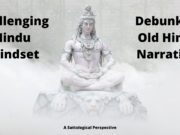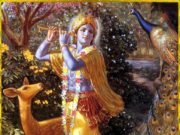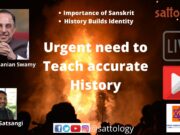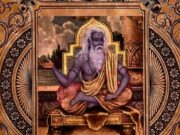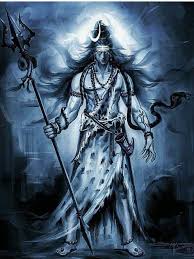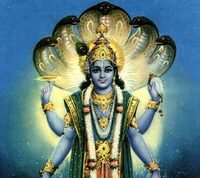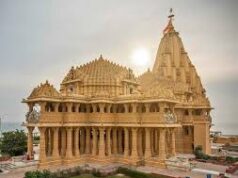Srimad Bhagavatam is often quoted by great acharyas from various traditions of Sanatana Dharma. The purity of Bhagavatam is held by one and all in all vedic traditions. Generally, it is historically acknowledged that it was spoken by the glorious Shukadeva Goswami to Maharaja Parikshit, son of Abhimanyu. Shukadeva Goswami was born of Krishna Dvaipayana Vyas and Dhritachi Apsara. The birth is special because Vyasadeva had prayed to Mahadeva for a glorious son who has all qualities of Agni, Vayu, Chandra and Surya. Vyasadeva had told Bhagavatam to Dhritachi and that was heard by Shukadeva in her womb. The name Shuka is also special which I have covered in my upcoming book. But the history of Bhagavatam goes much older than this. The reference of this is given by Bhagavan Krishna Himself in a conversation with Uddhava in Bhagavatam itself. Uddhava had gone to personally associate with Bhagavan Krishna in Prabhas Kshetra when He was about to depart from this earthly world after completing His earthly leela (लीला – a pastime to set an example for humanity). The great Maitreya Rishi was also present there to associate with Bhagavan. There, Bhagavan Krishna tells the history of Bhagavatam to his dear friend and also a disciple, Uddhava.
पुरा मया प्रोक्तमजाय नाभ्ये
पद्मे निषण्णाय ममादिसर्गे ।
ज्ञानं परं मन्महिमावभासं
यत्सूरयो भागवतं वदन्ति ॥ १३ ॥
‘In the beginning of creation I told My unlimited glories to Brahma, the unborn, who was situated on the lotus coming from My navel, which is called by Suras (सुर – those who follow Vedas) as Bhagavatam.’ This statement by Bhagavan Krishna Himself to Uddhava forms the basis of unlimited commentaries by great Acharyas of numerous Vedic sampradayas on this amazing text. In fact, amongst all the acharyas, this text has been the most discussed and taught Purana. When Maharaja Parikshit asked Shukadeva Goswami who had just returned from Surya loka back onto earth, for the specific purpose of instructing Parikshit by the will of Bhagavan Krishna. Shukadeva Goswami is an eternally liberated person and also the foremost Yogi, began telling Bhagavatam Puran with these words. There is no difference in what Bhagavan Krishna tells Uddhava and Shukadeva Goswami quoting Bhagavan Krishna Himself. This shows the continuity of similar information retold again at different times. The meeting between Uddhava and Bhagavan happened before the meeting between Shukadeva Goswami and Parikshit.
प्राह भागवतं नाम पुराणं ब्रह्मसम्मितम् ।
ब्रह्मणे भगवत्प्रोक्तं ब्रह्मकल्प उपागते ॥ २८ ॥
‘This Bhagavat Purana was spoken by Bhagavan Himself unto Brahma in the beginning of the day (कल्प Kalpa – one day of Brahma) of Brahma.’ The Bhagavatam has been existing in the human society for billions of years as per this statement and also certified by those who are expert in knowing the duration of Kalpa. This statement was made by Shukadeva Goswami to Maharaja Parikshit. Before this, Shukadeva Goswami informed Parikshit about his source of knowledge of this great Purana. Without Puranas it is impossible to understand the vedic context. Therefore, sincere students of Vedas respect all Puranas to develop a human understanding of the Vedas. Shukadeva Goswami informs Parikshit about the source of his knowledge of Bhagavat Purana.
इदं भागवतं नाम पुराणं ब्रह्मसम्मितम् ।
अधीतवान् द्वापरादौ पितुर्द्वैपायनादहम् ॥ ८ ॥
‘At the end of Dwapar Yuga, I learnt about Bhagavat Puran which is a supplement to Brahma-Sutra or Vedas from my father Krishna Dvaipayana Vyasa.’ For the present Kaliyuga, this text has been made available from the end of the period of Dwapar Yuga. Vyasadeva is the originator and Shukadeva Goswami is the secondary narrator for people of Kaliyuga. But, as I wrote before, this Bhagavatam was spoken by Bhagavan Himself to Brahma. It has been passed down through traditions to the present times. The message has not changed and cannot be modified because of the accuracy of Sanskrit language, however good the scholar may be. Ugrashrava or Suta Goswami, the son of Romaharshana spoke to sages at the Naimisharanya on Bhagavat Puran again later for the purpose of satisfying thousands of sages who had assembled in Naimisharanya (a place near Prayagraj) to hear from him. Suta Goswami had heard Bhagavatam directly from his Guru, Shukadeva Goswami before on the banks of Ganga when Shukadeva spoke to Parikshit. We must not confuse Shukadeva with Suta Goswami. Ugrashrava’ s father Romaharshana was one of the grand disciples of Vyasadeva who expanded Puranas under the authority of Vaishampayana.
निगमकल्पतरोर्गलितं फलं
शुकमुखादमृतद्रवसंयुतम् ।
पिबत भागवतं रसमालयं
मुहुरहो रसिका भुवि भावुका: ॥ ३ ॥
‘All the expert and thoughtful people of earth relish the sweetness of Bhagavatam, which is the fully matured fruit of Vedas, and which has become even more sweet by emanating from the mouth of ever liberated Shukadeva Goswami.’ In fact, when Shukadeva Goswami was speaking this Bhagavatam or Bhagavat Purana to Parikshit, Vyasadeva, Narada Muni, Asita-Devala, Parvat Muni and many other great luminaries of Vedas were sitting in the assembly and listening attentively. It is uniformly accepted as the crest jewel of all supplementaries of Vedas. That’s the reason why most Acharyas comment on this great text for their own purification from Karma Dosha. Shukadeva Goswami is also considered as the fifth disciple of Vyasadeva alongside Paila, Sumantu, Jaimini and Vaishampayan.
नारायणं नमस्कृत्य नरं चैव नरोत्तमम् ।
देवीं सरस्वतीं व्यासं ततो जयमुदीरयेत् ॥ ४ ॥
‘Let me offer my obeisances to Bhagavan Narayan & Nara-Narayan Rishi, Nara (the best amongst humans), Mother Sarasvati and Vyasadeva who have given us everything to become victorious over the cycle of birth & death’. This shloka has been said by Vaishampayan as well as Suta Goswami as well as Shukadeva Goswami. I have given a contextual meaning of the above shloka for better understanding. Jaya refers to all history that is given to human society to conquer the cycle of birth, old age, disease and death. Ramayan, Mahabharat, Puranas and Vedas are all Jaya. The eighteen thousand Shlokas of Bhagavat Puran contain the most authoritative summary of all Vedas. These Shlokas present the ultimate conclusions of Vedas along with summary information of all history that actually helps a human to attain freedom from Karma-cycle. Therefore, everyone can take advantage of this great Purana for their ultimate deliverance. It contains all Vedic histories including Ramayan and also conclusions of all Vedas for those interested in learning those topics, especially, when humans have made themselves extremely busy with various responsibilities or Dharma that they don’t have the time to read or understand Vedas. It is often recognized as the natural commentary on Brahm-Sutra or Vedanta. Most Vedantists also will get deeper understanding of Vedanta through Bhagavat Purana. Shukadeva Goswami is the highest Vedantist amongst humans universally recognized by all his contemporaries and even Mahadeva himself.
धर्म: प्रोज्झितकैतवोऽत्र परमो निर्मत्सराणां सतां
वेद्यं वास्तवमत्र वस्तु शिवदं तापत्रयोन्मूलनम् ।
श्रीमद्भागवते महामुनिकृते किं वा परैरीश्वर:
सद्यो हृद्यवरुध्यतेऽत्र कृतिभि: शुश्रूषुभिस्तत्क्षणात् ॥ २ ॥
(The readers of this article must send the meaning of this last shloka on an email at sattology@sattology.org)


